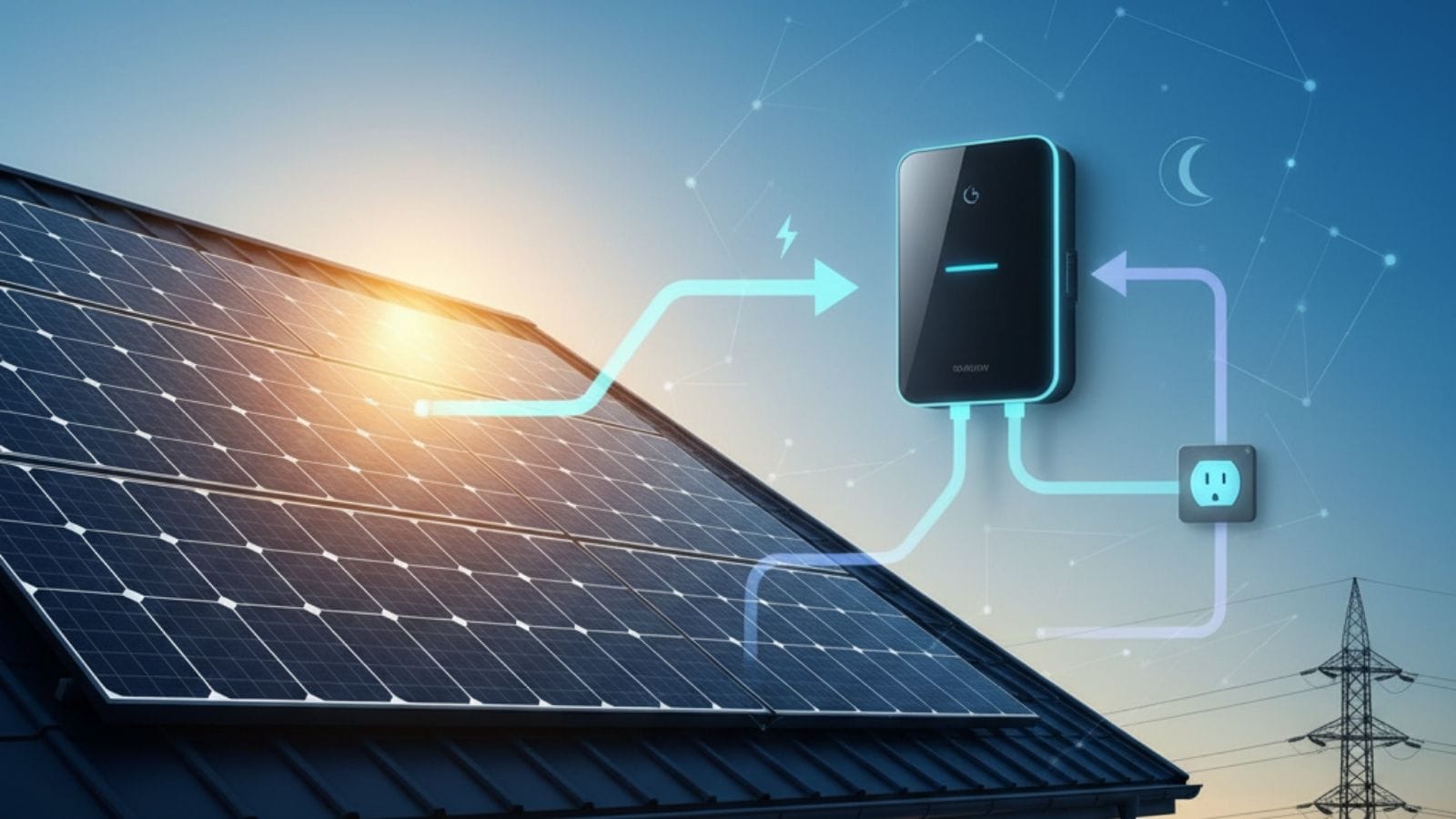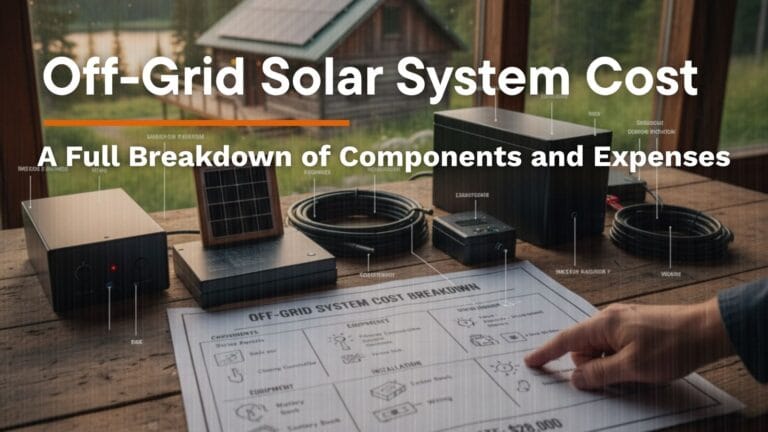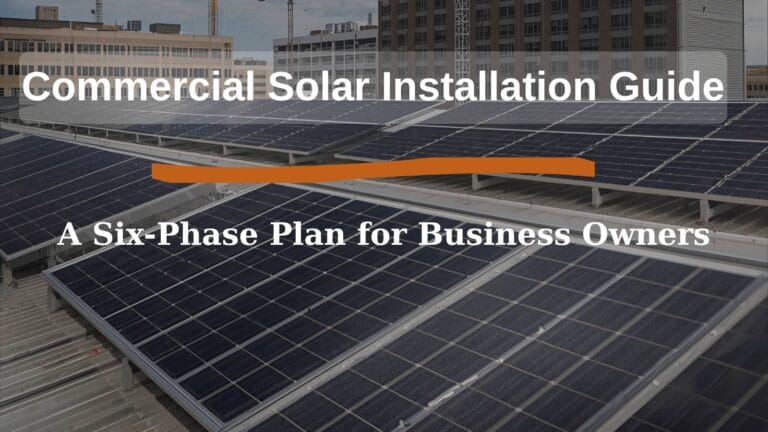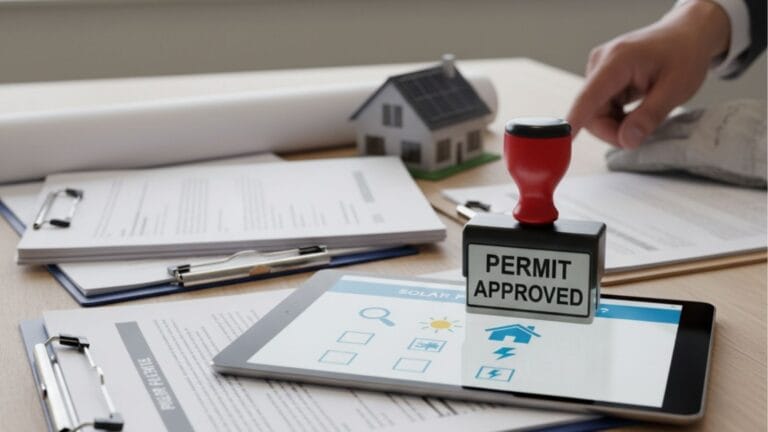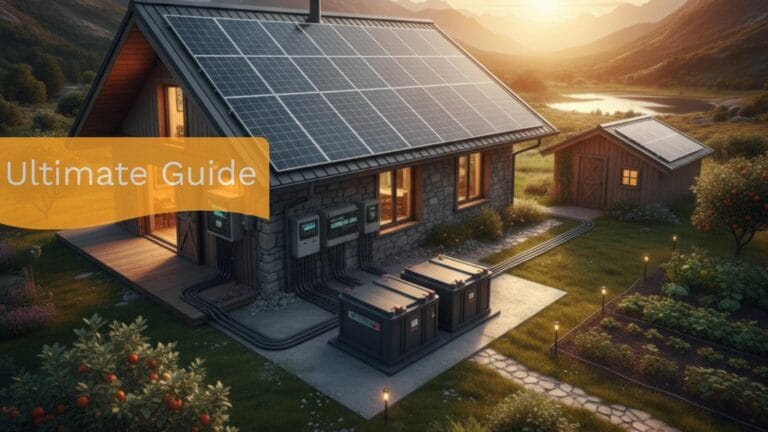How Solar Batteries Work with Solar Panels (Ultimate Guide)
As an Amazon Associate, I earn from qualifying purchases. This post contains affiliate links.
Integrating batteries with solar panels is no longer just a niche option—it’s now a core strategy for modern energy systems. According to in-depth technical reports from leading organizations like the International Renewable Energy Agency (IRENA), the National Renewable Energy Laboratory (NREL), and IEA PVPS, the synergy between solar and energy storage is a key driver for a resilient and sustainable power grid.
As a solar professional, I can tell you that understanding how these components interact is absolutely essential for system design, safety, and long-term performance. This isn’t a simple add-on; it’s a critical piece of a comprehensive energy solution. This in-depth guide is designed to help you navigate that complexity. We’ll explain battery operation, common connection methods, system configurations, and best practices. Every section is supported by current industry research and engineering standards to provide a reliable, authoritative resource for professionals and homeowners alike.
How do batteries work with solar panels?
Solar panels are incredible, but they only work when the sun is out. That’s where a battery comes in, acting as an essential energy reservoir that bridges the gap between solar production and energy demand. The panels convert sunlight into direct current (DC) electricity, and this current is then regulated and stored in a battery for later use, ensuring you have power around the clock.
This process is a precise synergy of three key steps:
- Energy Capture: During daylight hours, your photovoltaic cells are hard at work, capturing photons and generating DC power. This is the raw energy your system needs.
- Energy Regulation: Before that energy can be safely stored, it passes through a crucial component called a charge controller. This device ensures the proper voltage and current levels for the battery, preventing overcharging and protecting the battery’s health and longevity.
- Energy Discharge: When the sun goes down, or if a sudden storm rolls in, the stored energy is released from the battery to power your home’s appliances. This process ensures that your energy demand can be met consistently, reducing your reliance on grid power and giving you true energy autonomy.
Ultimately, a battery system turns intermittent solar power into a reliable, 24/7 energy source, providing peace of mind and greater energy independence.
How Do Solar Panels Connect to Batteries?
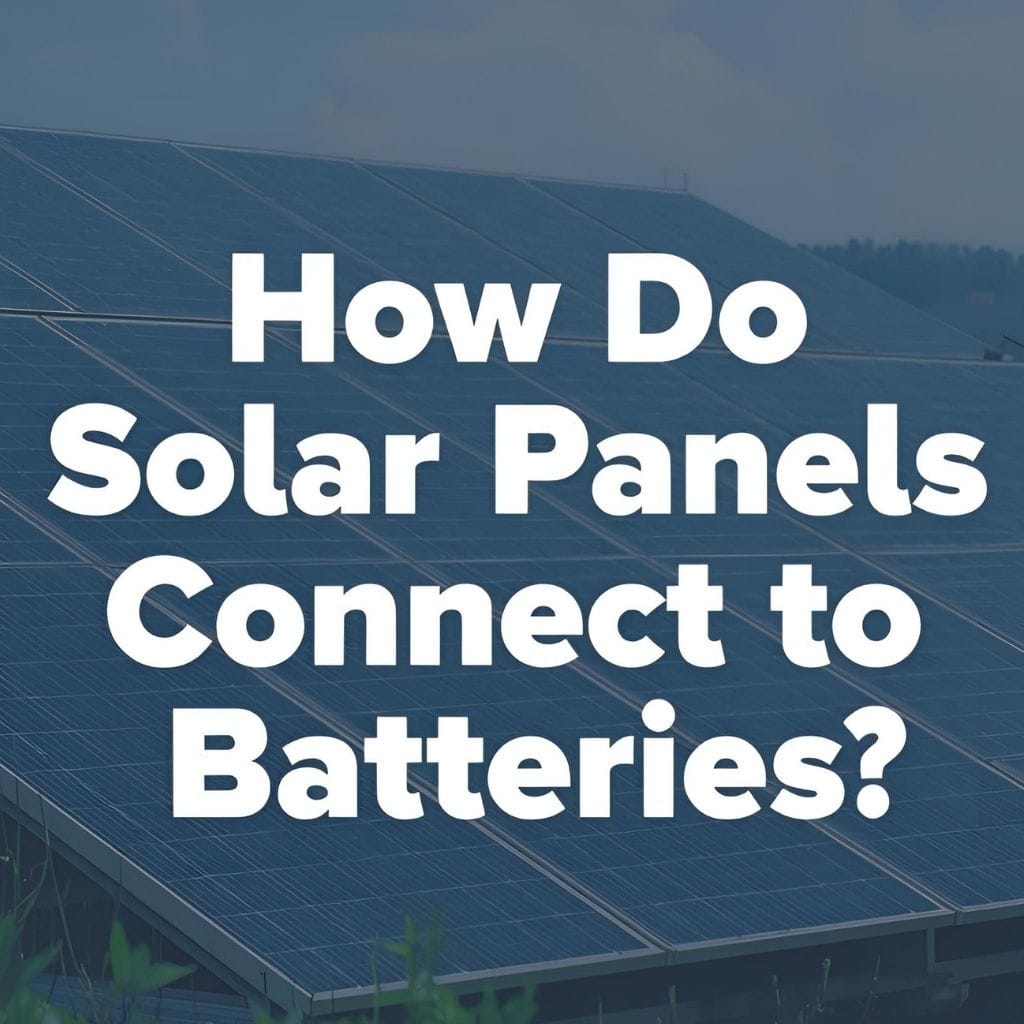
While you might think solar panels can connect directly to batteries, this is not standard practice and is actually quite dangerous. Panels are instead linked through a critical intermediary device called a solar charge controller. This component is the brain of the charging system, regulating the flow of electricity to protect the battery and ensure a safe, efficient charge.
The charge controller’s primary job is to prevent the panels from overcharging the battery, which can lead to damage, a reduced lifespan, or even a fire risk. It ensures the correct voltage and current levels are maintained at all times.
Key Connection and Safety Practices
To ensure a safe and effective system, industry standards and experts recommend several key practices:
Choose the Right Controller: Always use an MPPT (Maximum Power Point Tracking) controller for modern systems. Unlike simpler PWM controllers, MPPT technology can harvest up to 30% more energy from your panels by constantly adjusting the voltage to the battery’s optimal charging point.
Pro Recommendation: The Industry Standard Controller
As mentioned, an MPPT controller is essential for efficiency. For DIY systems, we highly recommend the Renogy Rover 40 Amp MPPT Controller. It is compatible with all battery types (including Lithium), has a clear LCD screen, and is incredibly reliable.
Ensure Proper Cable Sizing: Using the correct gauge of cable is critical. Cables that are too thin can cause a significant voltage drop, which leads to energy loss and can even cause the cables to overheat.
Pay Attention to Polarity and Compatibility: Reversing the polarity (positive and negative connections) can instantly damage both the charge controller and the battery. You must also ensure that the voltage of your solar panel array is compatible with both the charge controller and the battery bank.
As confirmed by manufacturers and certification bodies like TÜV Rheinland, professional installation is essential to ensure compliance with safety codes. This not only protects your investment but also guarantees the system is operating at its peak efficiency. For more in-depth information, the U.S. Department of Energy‘s guide on Solar Photovoltaic Systems is an excellent resource.
How Does Battery Backup Work with Solar Panels?
Think of a battery backup system as your personal energy reserve. It stores any surplus solar energy your panels generate during the day that your home isn’t using. This stored energy is then ready to power your home when solar production is low—whether due to nightfall, heavy cloud cover, or a grid outage.
In most modern setups, a hybrid inverter acts as the system’s central command. This device intelligently manages the flow of electricity, deciding whether to send power to your home, charge the battery, or sell excess energy back to the grid. This dynamic management ensures you’re always using power in the most efficient way possible.
Key Benefits of a Battery Backup System
Based on analyses from leading energy experts, a battery backup system offers several critical advantages:
- Protection During Outages: For homeowners, the most immediate benefit is peace of mind. A backup system ensures that critical appliances—like your refrigerator, lights, and medical devices—continue operating during power outages, keeping your home safe and functional.
- Enhanced Energy Reliability: In regions with unstable or unreliable grids, a battery is a game-changer. It provides a consistent power supply, helping you maintain energy reliability and independence from grid fluctuations.
- Smart Energy Management: Advanced battery systems and their management software can do more than just store power. They can actively manage your energy use by performing peak shaving and load shifting. This means the system can automatically discharge the battery during peak utility hours—when electricity prices are highest—and recharge it when rates are low, saving you a significant amount on your electricity bills.
In essence, a battery backup transforms your solar system from a simple power generator into a resilient and intelligent energy solution.ms your solar system from a simple power generator into a resilient and intelligent energy solution.
How do solar battery packs work?
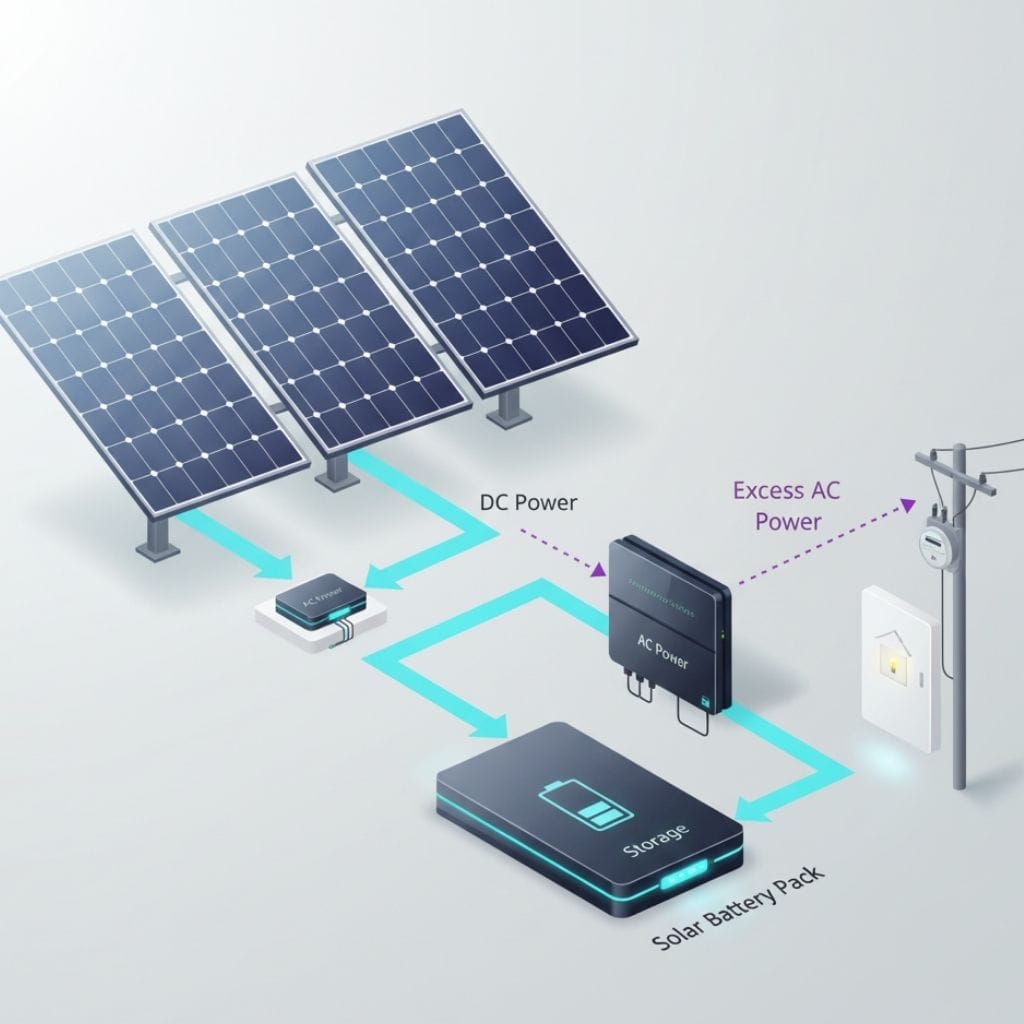
Solar battery packs are far more sophisticated than a simple car battery. They consist of multiple individual cells arranged in series and parallel configurations to achieve the desired voltage and capacity. But what truly makes them safe and efficient is the Battery Management System (BMS). This is a crucial piece of technology that acts as the battery’s brain, constantly monitoring critical parameters like voltage, temperature, and the overall state of charge across all cells.
The BMS performs several key functions:
- Balancing Cell Voltages: It actively balances the voltage across each cell in the pack. This is vital to prevent degradation, as an imbalance can lead to a single cell failing and reducing the lifespan of the entire battery pack.
- Limiting Current: It acts as a safety guard, limiting the current to avoid dangerous over-discharge or overcharge conditions. This not only protects the battery from damage but also prevents potential fire hazards.
- Providing Data: The BMS provides valuable data on the battery’s state of health and cycle count, giving both the user and the technician a clear picture of the battery’s condition and expected lifespan.
In modern installations, Lithium-iron-phosphate (LiFePO4) and other advanced lithium-ion chemistries have become the industry standard. This is due to their superior performance, high cycle life, and exceptional thermal stability, making them the safest and most reliable choice for solar energy storage.
Best Battery for Solar Storage:
For safety, longevity (4000+ cycles), and efficiency, we recommend switching to Lithium-Iron-Phosphate. The LiTime 12V 100Ah LiFePO4 Battery is a top choice because it features self-heating technology for cold weather charging, includes a built-in BMS, and can be monitored via Bluetooth.
How Long Will a 5 kWh Battery Last?
This is one of the most common questions people ask when they consider adding a battery to their solar system. The simple answer is that the runtime of a 5 kWh battery depends entirely on what you’re powering with it. Think of a battery like a fuel tank: the bigger the engine, the faster it empties. For batteries, the “engine” is your home’s energy consumption, or **”load”**.
The calculation is straightforward: you divide the battery’s capacity by the power draw of your appliances. For a 5 kWh battery, you need to consider not just the capacity but also the **Depth of Discharge (DoD)**, which is the percentage of the battery’s total capacity that you can use without damaging it. Most modern lithium-ion batteries are rated for a DoD of around 90-100%.
Here are a few real-world examples:
- Example 1: If your home has a continuous load of 1,000 watts (1 kW)—the equivalent of a few lights, a refrigerator, and a television—the battery would be depleted in approximately 5 hours.
- Example 2: If you only power a few essential items with a total load of 500 watts, the battery would last roughly 10 hours.
- Example 3: It’s also important to consider high surge loads. Appliances like air conditioners or well pumps draw a huge amount of power for a short period when they start up. These surges can temporarily reduce the usable capacity of your battery.
To get a more accurate idea of your needs, experts recommend sizing your battery bank to cover your typical daily consumption, plus a safety margin to account for cloudy days or unexpected grid outages. It’s always better to have a little more capacity than you need to ensure you have power when it matters most.
What happens to solar panels when batteries are full?
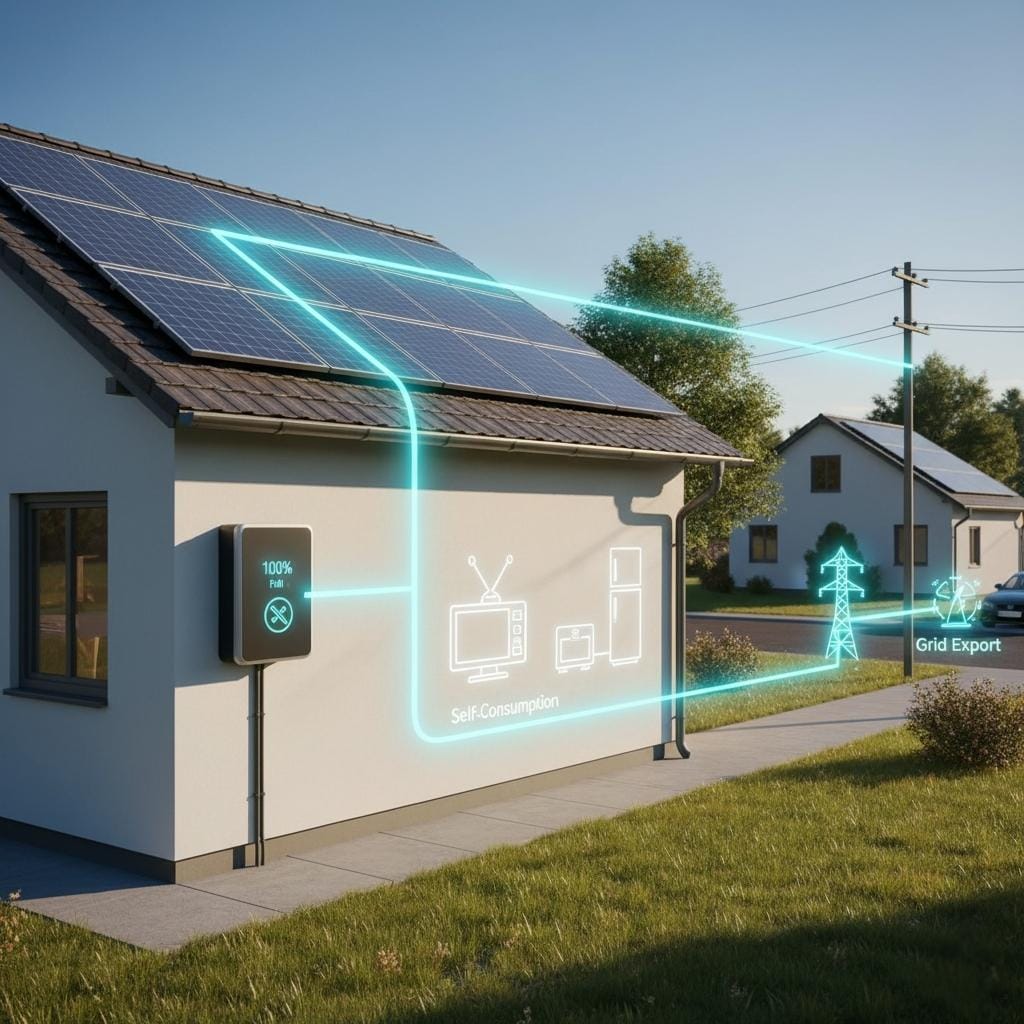
Once a battery reaches a 100% state of charge (SoC), the charge controller takes over. It’s programmed to limit or completely stop the current flow to the battery to prevent overcharging, which can be a major safety risk and severely damage the battery’s lifespan. But what happens to all that extra power your solar panels are still generating?
The system has a few smart options for managing this surplus energy:
- Exporting to the Grid: The most common solution is to send the excess power back to the grid. Under net metering policies, your utility company credits you for this energy, effectively turning your solar system into a revenue source.
- Diverting to Other Loads: Your system can be configured to automatically divert surplus energy to secondary, non-critical loads. This could be anything from heating the water in your tank to charging an electric vehicle (EV) or running a pool pump. This is a great way to use your free energy and reduce your overall utility bill.
- Curtailment: In rare cases, if a battery is full and the grid connection is down, the charge controller may simply reduce the output of the solar panels (a process known as curtailment) to maintain system safety. This is a protective measure to ensure the system doesn’t generate more power than it can handle.
Advanced hybrid inverters are the key to this process. They seamlessly automate these decisions, ensuring battery health and compliance with safety standards without any input from you.
Can I connect solar panels directly to a battery?
Absolutely not. Connecting solar panels directly to batteries bypasses essential regulation and is not only ill-advised but can be extremely dangerous. Without a charge controller, you lose all control over the flow of electricity, which can lead to severe damage to your equipment and create significant safety risks.
Why Direct Connection is a Bad Idea
- Overcharging: Solar panels will continue to produce current as long as they’re exposed to sunlight. Without a charge controller to regulate this flow, batteries can be pushed beyond their full capacity. This overcharging can cause a battery to overheat, swell, and even lead to a fire or explosion. It’s a bit like trying to fill a water bottle with a fire hose—you’ll end up with a huge mess and a broken bottle.
- Deep Discharges: On the other hand, a direct connection offers no protection against deep discharge. If you draw too much power from the battery without a charge controller to shut it off, you can drain it completely. This is one of the quickest ways to damage a battery’s internal chemistry, drastically reducing its cycle life and rendering it useless long before its time.
- Major Safety Hazards: Unregulated charging and discharging increase the risk of serious hazards, including fire and chemical leakage. Modern batteries, especially lithium-ion, require a sophisticated Battery Management System (BMS) to operate safely, and a charge controller is a critical part of that safety chain.
The Professional Consensus
This isn’t just a recommendation—it’s a fundamental safety requirement. Industry standards from respected organizations like the International Electrotechnical Commission (IEC) and Underwriters Laboratories (UL) mandate regulated charging for any solar-battery system. Reputable reports, such as those from the International Renewable Energy Agency (IRENA), consistently highlight regulated charging as a core best practice for PV systems. Ultimately, a charge controller is a non-negotiable component that protects your investment, your property, and your safety.
Can you run 2 solar panels to 1 battery?
Yes, multiple solar panels can charge a single battery, but it’s a critical process that must be done correctly. Simply connecting them all in a big bundle is a recipe for inefficiency and, in some cases, can be dangerous. From a professional standpoint, a properly designed system is the only way to ensure safety, maximum output, and longevity.
Key Design Principles for Multi-Panel Systems
In a multi-panel, single-battery setup, every component must be carefully matched to the others. Think of it like a team of horses pulling a cart: if they aren’t all working in unison, you’ll lose power. Here’s what experts recommend to get it right:
- Wiring for the Right Voltage: Your solar panels must be wired together in a way that provides the correct voltage for your charge controller and battery bank. You can connect panels in series to increase the voltage or in parallel to increase the current. A professional will perform these calculations to ensure every panel is contributing effectively without creating a bottleneck.
- Sizing the Charge Controller: This is a non-negotiable step. Your charge controller must be able to handle the combined current from all your panels. An undersized controller will be overloaded and can fail, leading to wasted power and a risk of fire. Always choose a controller with a safety margin that can handle more than the maximum power your panels can generate.
- Ensuring Panel Consistency: To get the best performance, you should use identical panels. Panels from different manufacturers or even different production batches can have slight variations in voltage and current output. This variation, known as mismatch loss, means the most powerful panels will be held back by the weakest ones. Using identical panels helps ensure the entire array works as a single, optimized unit, preventing a “weakest link” from dragging down your overall energy harvest.
By following these fundamental design principles, you’ll create a reliable and efficient system that fully utilizes the power of every single panel you install.
How do solar panels work at night without batteries?
You’re right. Solar panels are not magic; they’re a passive technology that requires sunlight to produce electricity. When the sun goes down, your panels stop generating power. This means that to have electricity after sunset, the power must come from somewhere else.
This is a fundamental concept for anyone considering solar, and it’s why a complete system often involves more than just panels.
The Two Main Solutions for Nighttime Power
There are two primary ways to ensure you have electricity when your panels aren’t producing:
- Energy Storage (Batteries): This is the most common solution for modern residential solar systems. During the day, your panels produce more power than your home needs, and the excess energy is stored in a battery. When night falls, your home automatically switches to drawing power from the battery. This allows you to use your own clean, solar-generated electricity around the clock, providing a level of energy independence from the grid.
- Grid Connection: The majority of solar systems are connected to the main utility grid. When your panels aren’t producing, your home simply switches back to drawing power from the grid, just like a traditional home. This is often part of a net metering agreement, where you sell your excess solar energy to the grid during the day and buy power back at night, effectively using the grid as a giant, virtual battery.
Without one of these two solutions—a battery or a grid connection—your solar system cannot supply electricity after sunset. It’s a simple fact of solar physics.et.
How long do solar batteries last?
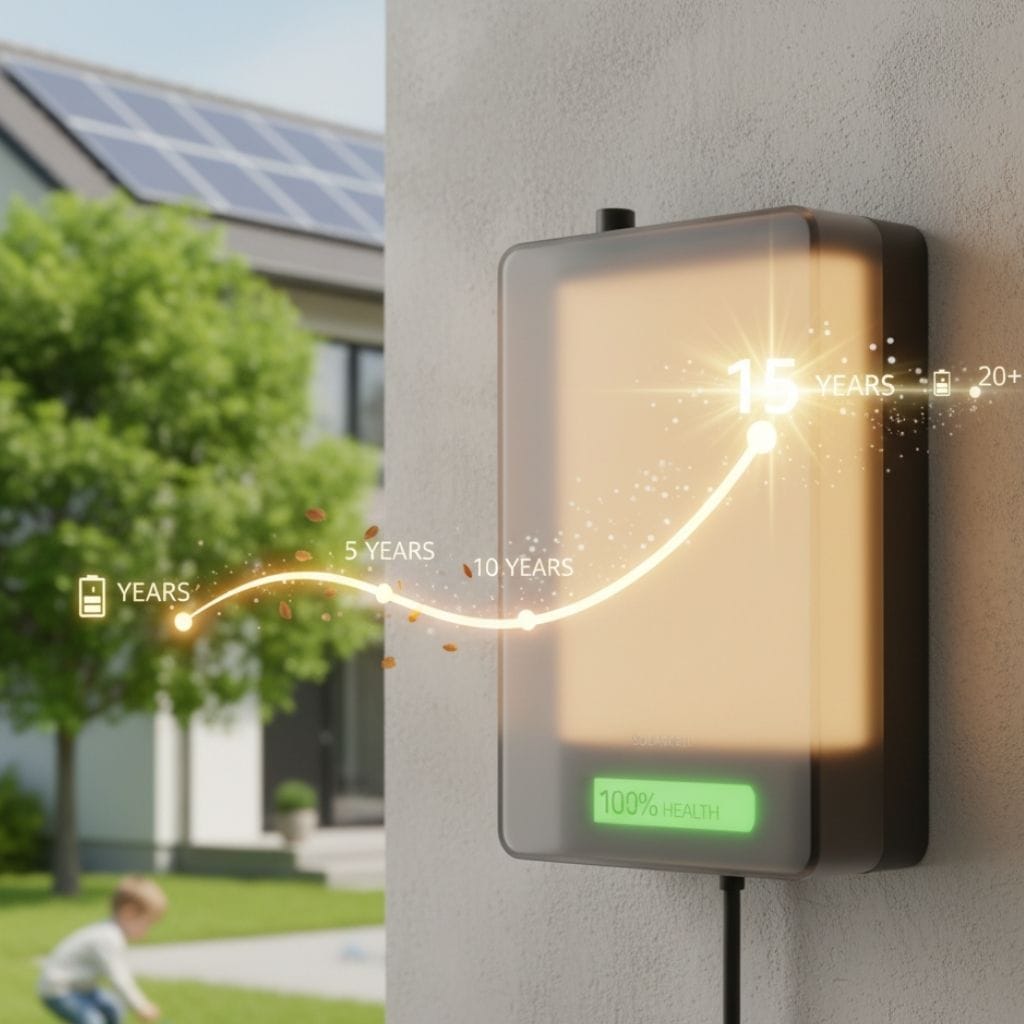
The lifespan of a solar battery is measured in two key ways: cycles and years. This is a crucial distinction, as a battery’s life is determined not just by how old it is, but by how much it’s used.
Understanding Battery Lifespan
Cycles: A cycle is one full charge and one full discharge of the battery. Think of it like a car’s mileage; the more you use it, the faster you’ll reach its end-of-life rating.
Years: This refers to the calendar age of the battery, regardless of how many cycles it has completed.
For modern solar systems, the two most common battery types have very different lifespans. Lithium-ion batteries are the industry standard, typically lasting 10–15 years with a high cycle count of 4,000–6,000 cycles. They can be fully discharged without significant harm, making them ideal for daily use. In contrast, older lead-acid batteries have an average life of 5–8 years with a much lower cycle count of just 500–1,000 cycles. They are also more sensitive to deep discharges, which can drastically shorten their life.
How to Maximize Your Battery’s Life
Proper care and maintenance are the most effective ways to extend a battery’s life far beyond the manufacturer’s minimums. This is where advanced technology and best practices come in:
Temperature Control: Extreme temperatures, both hot and cold, are a battery’s worst enemy. Storing batteries in a climate-controlled environment can significantly extend their lifespan.
Battery Management System (BMS): A modern BMS is a must-have. It’s the “brain” that monitors and protects the battery from damage. Studies consistently show that systems with a good BMS can extend usable life by actively managing voltage and temperature to prevent degradation.
Controlled Depth of Discharge (DoD): While lithium-ion batteries can be discharged deeply, consistently keeping the discharge level above a certain threshold (e.g., not regularly discharging below 20%) can further extend the number of usable cycles.
Ultimately, investing in a high-quality battery and taking the time for proper maintenance is the best way to secure your energy independence for years to come.
Common Myths and Facts About Solar Batteries
Solar batteries are a hot topic in the renewable energy world, and with that popularity comes a lot of misinformation. As a professional in the field, I’ve heard every myth in the book. Let’s separate the facts from the fiction to help you make an informed decision about energy storage.
Myth: Batteries Store Unlimited Energy.
Fact: This is one of the most common misconceptions. A battery is essentially a fuel tank, and like any tank, it has a fixed capacity. That capacity is measured in kilowatt-hours (kWh). For example, a 10 kWh battery can store exactly that much energy—no more, no less. It can be used to power a few critical appliances for a couple of days during an outage, but it’s not a magical, infinite power source. Sizing your battery bank correctly based on your energy consumption is one of the most critical steps in system design.
Myth: Solar Batteries Are Only for Off-Grid Setups.
Fact: While batteries are essential for off-grid living, the vast majority are installed in homes that are still connected to the grid. In these grid-tied systems, a battery’s main job is to boost self-consumption. This means you can use the power your panels generate during the day at night, instead of selling it to the utility at a low rate and buying it back at a higher rate. This “time-shifting” of energy is a powerful way to reduce your electricity bills and increase your energy independence.
Myth: Maintenance Is Unnecessary.
Fact: This is a dangerous myth. While modern lithium-ion batteries require far less maintenance than older lead-acid models, they are not “install and forget” devices. Regular inspections and firmware updates are crucial for a battery’s health and longevity. The Battery Management System (BMS), which controls charging and discharging, receives updates that improve performance and address potential issues. Ignoring these can lead to reduced efficiency and a shortened lifespan. Just like your smartphone, a little bit of maintenance goes a long way. A professional inspection every one to two years is a sound investment in your system’s long-term performance.
Skip the Wiring: The All-in-One Alternative
If building a custom battery bank with charge controllers and inverters feels too complex, consider a “Solar Generator.” These devices combine the battery, MPPT controller, and inverter into one portable box.
Our Pick: BLUETTI AC200L Portable Power Station It plugs directly into solar panels and can power 90% of home appliances during an outage without any installation required. [Check Price & Reviews on Amazon]
Design and Installation Recommendations
When it comes to solar battery systems, a proper design and a professional installation are just as important as the components themselves. Taking the time to get this right will save you money and headaches down the road. Here are the key recommendations that experts consistently emphasize for a safe and effective system.
Choose Your Components Wisely
- Use MPPT Charge Controllers: This is a non-negotiable recommendation for modern systems. An MPPT (Maximum Power Point Tracking) controller can extract significantly more energy from your solar panels, especially on cloudy days or when temperatures fluctuate. It’s an easy way to boost your system’s efficiency without adding more panels.
- Prioritize Safety and Certification: Your system should always adhere to industry safety standards. Look for components that comply with standards like IEC 62109 and UL 1741. These certifications prove that a product has been rigorously tested for safety, compatibility, and performance, giving you peace of mind that your system won’t become a fire hazard.
Smart Installation Practices
- Provide Adequate Ventilation: Batteries generate heat, and excessive thermal stress can severely reduce their lifespan. Ensure your battery bank is installed in a well-ventilated area with a consistent temperature. This simple step protects your investment and ensures the battery lasts as long as possible.
- Size Your Battery Bank Correctly: Don’t rely on guesswork. Your battery bank should be sized based on your real load profiles—the actual amount of energy you use. An undersized battery won’t meet your needs, while an oversized one is a waste of money. A professional can help you analyze your energy consumption data to find the perfect fit.
- Plan for Scalability: The best systems are designed with the future in mind. By integrating modular battery packs, you can easily add more storage capacity as your energy needs grow, without having to replace your entire system. This protects your initial investment and gives you flexibility for years to come.
In essence, a professional, well-planned installation is the best way to secure your energy autonomy and ensure your solar and battery system performs exactly as expected for its full lifespan.
Solar panels and batteries form a truly dynamic partnership that is the cornerstone of modern, sustainable power systems. It’s more than just an assembly of parts; it’s a symbiotic relationship where one component’s strength compensates for the other’s weakness. Through proper design, regulated connections, and strict adherence to global standards, these integrated systems deliver a level of energy independence and long-term value that solar panels alone simply can’t match.
Whether you are planning a small residential system, a large-scale commercial installation, or a sophisticated hybrid setup, following expert recommendations is non-negotiable. This is the only way to ensure optimal performance, extended lifespan, and the safety of your investment. It is this combination of reliable technology and professional installation that allows solar to move beyond being just an intermittent power source and become a truly consistent and reliable cornerstone of our energy future.
Click to read our blog post, How Long Do Solar Panels Last? (And How to Extend Their Life).

Solar Energy Enthusiast & Renewable Energy Researcher
Vural’s journey into solar energy began four years ago, driven by frequent power outages and high electricity bills at his own home. He has since gained hands-on experience with both personal and commercial solar projects. At solarpanelresource.com, Vural shares his real-world insights and in-depth research to guide homeowners and business owners on their own path to energy independence.

